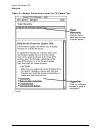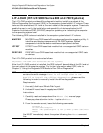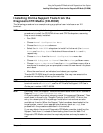
58 Chapter 5
Using the Diagnostic/IPR Media to Install Diagnostics on Your System
HP Predictive Support
HP Predictive Support
HP Predictive Support helps improve the reliability of your HP 9000 Series 800s by
monitoring disk/tape drives and system memory for potential problems. If a potential
problem is detected, HP Predictive Support transfers this information to the
Hewlett-Packard Response Center.
HP Predictive Support monitors hardware by automatically collecting system information
and comparing it against historical data and predetermined thresholds. Then it reports
configuration changes, exceeded thresholds, and significant errors.
How the Process Works
HP Predictive Support involves your entire HP support team to help you monitor, prevent,
and resolve problems with your systems and peripherals:
1. Potential problem? After analyzing your system and peripherals, HP Predictive
Support sends any information on potential problems to the HP Response
Center.
2. HP Response Center analyzes the
problem. An HP Response Center Engineer (RCE) analyzes the data and adds it to
the system's history. If further action is needed, the RCE may ask the
system administrator to perform remote diagnostics, or may forward the
information to the HP Account CE.
3. HP Account CE may provide
backup support. The Account CE may suggest corrective actions to the system
administrator, or schedule a visit within the support agreement coverage
hours.
Usually, all of this activity occurs before there is any noticeable impact to system
performance.
What HP Predictive Support Covers
HP Predictive Support covers:
• Disk drives, by scanning the onboard logs of CS80 and SCSI/Fast-Wide SCSI disk
drives, and system logs. The DISCSCAN, SCSISCAN, and LOGSCAN utilities
provide coverage on disk drives.
• Memory, by scanning the memory logs with the MEMSCAN utility.
• Tape drives, by scanning system log files with the LOGSCAN utility.
• Low Priority Machine Checks (LPMC), by scanning system log files with the
LOGSCAN utility.


















